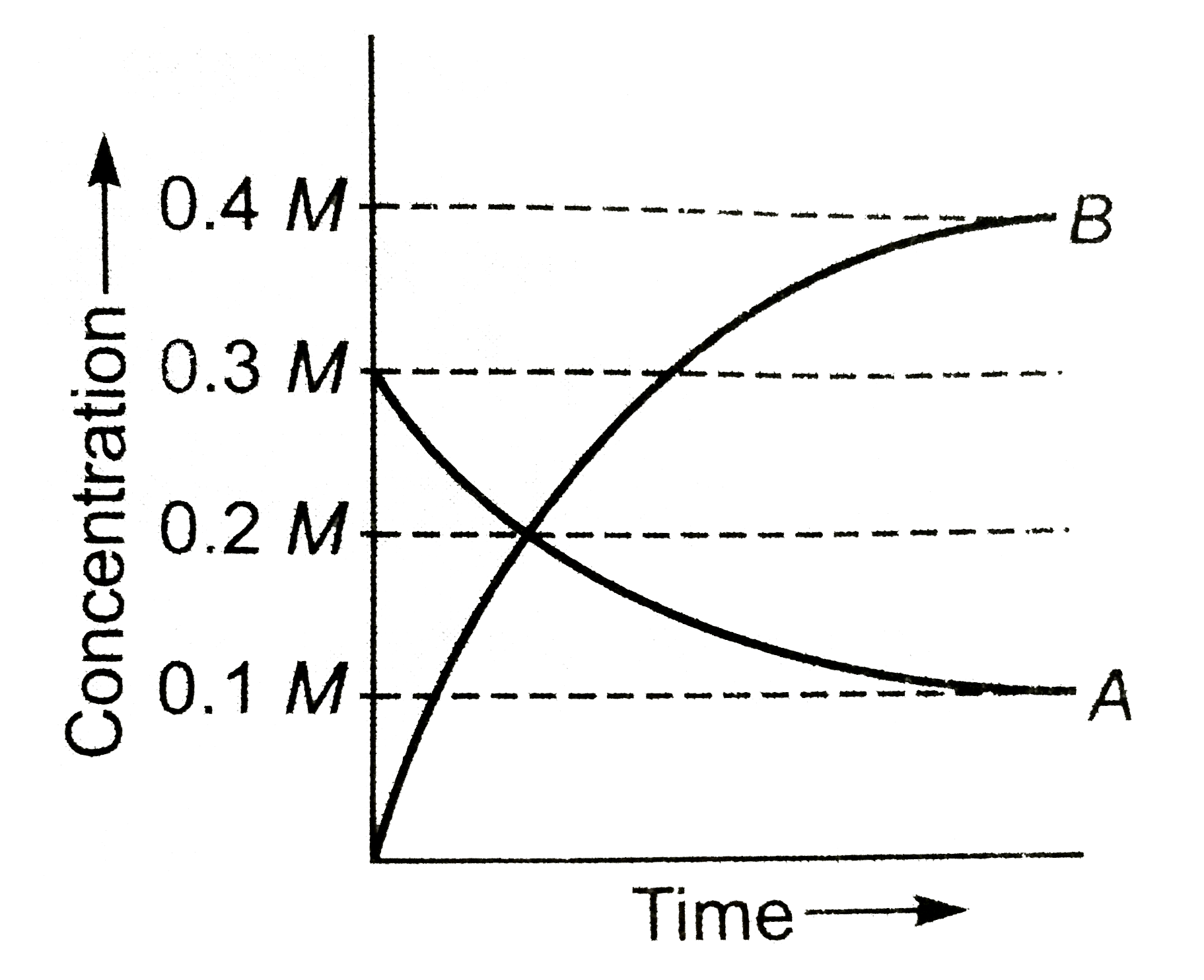What is the equilibrium concentration of each of the substance in the equilibrium when the initial concentration of ICl was 0.78M?
2ICl(g)⇔I2(g)+Cl2(g),Kc=0.14
The correct Answer is:[I2]=[Cl2]=0.167M.[ICl]=0.0446M
To find the equilibrium concentrations of each substance in the reaction 2ICl(g)⇌I2(g)+Cl2(g) with an initial concentration of ICl=0.78M and Kc=0.14, we can follow these steps:
Step 1: Set up the initial concentrations
At the start of the reaction (t = 0):
- (ICl)=0.78M
- (I2)=0M
- (Cl2)=0M
Step 2: Define the change in concentrations
Let x be the amount of ICl that dissociates at equilibrium. The changes in concentration will be:
- (ICl)=0.78−2x
- (I2)=x
- (Cl2)=x
Step 3: Write the expression for Kc
The equilibrium constant expression for the reaction is given by:
Kc=(I2)(Cl2)(ICl)2
Substituting the equilibrium concentrations into this expression gives:
0.14=x⋅x(0.78−2x)2
This simplifies to:
0.14=x2(0.78−2x)2
Step 4: Solve for x
Cross-multiplying gives:
0.14(0.78−2x)2=x2
Expanding the left side:
0.14(0.6084−3.12x+4x2)=x2
This simplifies to:
0.085176−0.4368x+0.56x2=x2
Rearranging gives:
−0.44x2−0.4368x+0.085176=0
Multiplying through by -1:
0.44x2+0.4368x−0.085176=0
Step 5: Use the quadratic formula
Using the quadratic formula x=−b±√b2−4ac2a:
- a=0.44
- b=0.4368
- c=−0.085176
Calculating the discriminant:
b2−4ac=(0.4368)2−4(0.44)(−0.085176)
Calculating gives:
0.1915+0.1507=0.3422
Now substituting back into the quadratic formula:
x=−0.4368±√0.34222×0.44
Calculating the square root and the values for x:
x≈0.166
Step 6: Calculate equilibrium concentrations
Now we can find the equilibrium concentrations:
- (ICl)=0.78−2(0.166)=0.78−0.332=0.448M
- (I2)=x=0.166M
- (Cl2)=x=0.166M
Final Answer
The equilibrium concentrations are:
- (ICl)=0.448M
- (I2)=0.166M
- (Cl2)=0.166M
At the start of the reaction (t = 0):
- (ICl)=0.78M
- (I2)=0M
- (Cl2)=0M
Let x be the amount of ICl that dissociates at equilibrium. The changes in concentration will be:
- (ICl)=0.78−2x
- (I2)=x
- (Cl2)=x
The equilibrium constant expression for the reaction is given by:
Kc=(I2)(Cl2)(ICl)2
Substituting the equilibrium concentrations into this expression gives:
0.14=x⋅x(0.78−2x)2
This simplifies to:
0.14=x2(0.78−2x)2
Cross-multiplying gives:
0.14(0.78−2x)2=x2
Expanding the left side:
0.14(0.6084−3.12x+4x2)=x2
This simplifies to:
0.085176−0.4368x+0.56x2=x2
Rearranging gives:
−0.44x2−0.4368x+0.085176=0
Multiplying through by -1:
0.44x2+0.4368x−0.085176=0
Using the quadratic formula x=−b±√b2−4ac2a:
- a=0.44
- b=0.4368
- c=−0.085176
b2−4ac=(0.4368)2−4(0.44)(−0.085176)
Calculating gives:
0.1915+0.1507=0.3422
Now substituting back into the quadratic formula:
x=−0.4368±√0.34222×0.44
Calculating the square root and the values for x:
x≈0.166
Now we can find the equilibrium concentrations:
- (ICl)=0.78−2(0.166)=0.78−0.332=0.448M
- (I2)=x=0.166M
- (Cl2)=x=0.166M
The equilibrium concentrations are:
- (ICl)=0.448M
- (I2)=0.166M
- (Cl2)=0.166M
Topper's Solved these Questions
Similar Questions
If the equilibrium constant of the reaction 2HI⇔H2+I2 is 0.25, then the equilibrium constant for the reaction, H2(g)+I2(g)⇔2HI(g) would be
View SolutionKp=0.04atm at 899K for the equilibrium shown below. What is the equilibrium concentration of C2H6 when it is placed in a flask at 4.0atm pressure and allowed to come to equilibrium?
C2H6(g)⇔C2H4(g)+H2(g)
View Solution
Knowledge Check
PCl5,PCl3andCl2 are at equilibrium at 500 K with concentration 2.1M PCl3, 2.1M Cl2 and 1.9M PCl5.
The equilibrium constant for the given reaction is
PCl5(g)⇔PCl3(g)+Cl2(g)A(a) 2.32B(b) 1.79C(c) 4.2D(d) 3.8
A(g)+3B(g)→4C(g)Initially concentration of A is equal to that of B. The equilibrium concentrations of A and C are equal. Kc is :
View SolutionWhat is Kc for the following equilibrium concentration of each substance is:
[SO2]=0.60M,[O2]=0.82M and [SO3]=1.90M?
2SO2(g)+O2(g)⇔2SO3(g)
View SolutionWhat is Kc for the following equilibrium concentration of each substance is:
[SO2]=0.60M,[O2]=0.82M and [SO3]=1.90M?
2SO2(g)+O2(g)⇔2SO3(g)
View SolutionThe figure shows the change in concentration of species A and B as a function of time.
The equilibrium constant Kcfor the reactionA(g)⇔2B(g) is :

View SolutionA(G)+B(g)⇔C(g)+D(g)
Above equilibrium is established by taking A& B in a closed container. Initial concentration of A is twice of the initial concentration of B. At equilibrium concentraons of B and C are equal. Then find the equilibrium constant for the reaction, C(g)+D(g)⇔A(g)+B(g).
View Solution2ICl→I2+Cl2 KC=0.14
Initial concentration of ICl is 0.6 M then equilibrium concentration of I2 is:
View SolutionWhat concentration of CO2 be in equilibrium with 0.025M CO at 120∘C for the reaction
FeO(s)+CO(g)⇔Fe(s)+CO2(g)
if the value of Kc=5.0 ?
View Solution
